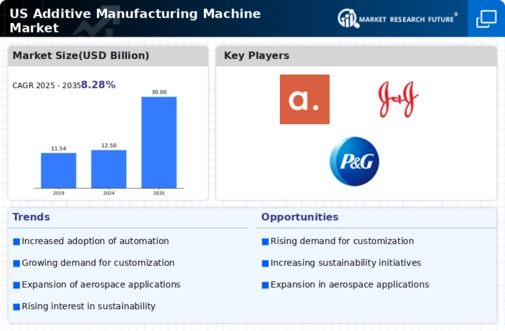Cost Efficiency and Waste Reduction
Cost efficiency and waste reduction are pivotal drivers in the additive manufacturing-machine market. Traditional manufacturing methods often involve significant material waste and high production costs. In contrast, additive manufacturing allows for layer-by-layer construction, which minimizes waste and optimizes material usage. This efficiency is particularly appealing to industries facing stringent budget constraints. Reports indicate that companies utilizing additive manufacturing can reduce material costs by up to 50%, making it an attractive alternative. As organizations increasingly focus on cost-effective solutions, the adoption of additive manufacturing technologies is likely to rise, thereby enhancing market growth.
Rising Demand for Prototyping Solutions
The additive manufacturing-machine market is significantly influenced by the increasing demand for rapid prototyping solutions. Companies are seeking to reduce time-to-market for new products, and additive manufacturing provides a viable solution by enabling quick iterations and modifications. This trend is particularly pronounced in the automotive and consumer goods sectors, where prototyping is critical for product development. According to recent data, the prototyping segment accounts for nearly 30% of the total market share, highlighting its importance. As businesses continue to prioritize innovation, the reliance on additive manufacturing for prototyping is expected to grow, further propelling market expansion.
Technological Advancements in 3D Printing
The additive manufacturing-machine market is experiencing a surge due to rapid technological advancements in 3D printing technologies. Innovations such as improved materials, faster printing speeds, and enhanced precision are driving demand across various sectors. For instance, the introduction of multi-material printing capabilities allows for the creation of complex geometries that were previously unattainable. This evolution is particularly evident in industries like aerospace and healthcare, where customized components are essential. The market was projected to grow at a CAGR of approximately 25% from 2025 to 2030, indicating a robust expansion driven by these technological improvements.
Growing Adoption in Healthcare Applications
The additive manufacturing-machine market is witnessing a notable increase in adoption within healthcare applications. The ability to create customized implants, prosthetics, and surgical tools tailored to individual patient needs is revolutionizing the medical field. This trend is supported by advancements in bioprinting technologies, which enable the production of living tissues and organs. According to industry estimates, the healthcare segment is projected to account for over 20% of the market by 2030. As healthcare providers seek innovative solutions to improve patient outcomes, the demand for additive manufacturing technologies is likely to expand, contributing to overall market growth.
Increased Investment in Research and Development
Investment in research and development (R&D) is a crucial factor influencing the additive manufacturing-machine market. Companies are allocating substantial resources to explore new applications and improve existing technologies. This trend is evident in sectors such as aerospace, where R&D efforts are focused on developing lightweight materials and advanced printing techniques. The U.S. government has also recognized the potential of additive manufacturing, providing funding for initiatives aimed at fostering innovation. As R&D investments continue to grow, the market is expected to benefit from enhanced capabilities and new product offerings, driving further adoption.














Leave a Comment